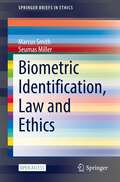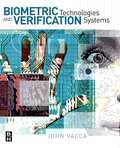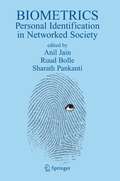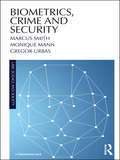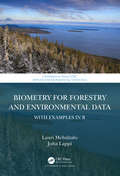- Table View
- List View
Biometric-Based Physical and Cybersecurity Systems
by Mohammad S. Obaidat Issa Traore Isaac WoungangThis book presents the latest developments in biometrics technologies and reports on new approaches, methods, findings, and technologies developed or being developed by the research community and the industry. The book focuses on introducing fundamental principles and concepts of key enabling technologies for biometric systems applied for both physical and cyber security. The authors disseminate recent research and developing efforts in this area, investigate related trends and challenges, and present case studies and examples such as fingerprint, face, iris, retina, keystroke dynamics, and voice applications . The authors also investigate the advances and future outcomes in research and development in biometric security systems. The book is applicable to students, instructors, researchers, industry practitioners, and related government agencies staff. Each chapter is accompanied by a set of PowerPoint slides for use by instructors.
The Biometric Computing: Recognition and Registration
by Karm Veer Arya Robin Singh Bhadoria"The Biometric Computing: Recognition & Registration" presents introduction of biometrics along with detailed analysis for identification and recognition methods. This book forms the required platform for understanding biometric computing and its implementation for securing target system. It also provides the comprehensive analysis on algorithms, architectures and interdisciplinary connection of biometric computing along with detailed case-studies for newborns and resolution spaces. The strength of this book is its unique approach starting with how biometric computing works to research paradigms and gradually moves towards its advancement. This book is divided into three parts that comprises basic fundamentals and definitions, algorithms and methodologies, and futuristic research and case studies. Features: A clear view to the fundamentals of Biometric Computing Identification and recognition approach for different human characteristics Different methodologies and algorithms for human identification using biometrics traits such as face, Iris, fingerprint, palm print, voiceprint etc. Interdisciplinary connection of biometric computing with the fields like deep neural network, artificial intelligence, Internet of Biometric Things, low resolution face recognition etc. This book is an edited volume by prominent invited researchers and practitioners around the globe in the field of biometrics, describes the fundamental and recent advancement in biometric recognition and registration. This book is a perfect research handbook for young practitioners who are intending to carry out their research in the field of Biometric Computing and will be used by industry professionals, graduate and researcher students in the field of computer science and engineering.
The Biometric Computing: Recognition and Registration
by Karm Veer Arya Robin Singh Bhadoria"The Biometric Computing: Recognition & Registration" presents introduction of biometrics along with detailed analysis for identification and recognition methods. This book forms the required platform for understanding biometric computing and its implementation for securing target system. It also provides the comprehensive analysis on algorithms, architectures and interdisciplinary connection of biometric computing along with detailed case-studies for newborns and resolution spaces. The strength of this book is its unique approach starting with how biometric computing works to research paradigms and gradually moves towards its advancement. This book is divided into three parts that comprises basic fundamentals and definitions, algorithms and methodologies, and futuristic research and case studies. Features: A clear view to the fundamentals of Biometric Computing Identification and recognition approach for different human characteristics Different methodologies and algorithms for human identification using biometrics traits such as face, Iris, fingerprint, palm print, voiceprint etc. Interdisciplinary connection of biometric computing with the fields like deep neural network, artificial intelligence, Internet of Biometric Things, low resolution face recognition etc. This book is an edited volume by prominent invited researchers and practitioners around the globe in the field of biometrics, describes the fundamental and recent advancement in biometric recognition and registration. This book is a perfect research handbook for young practitioners who are intending to carry out their research in the field of Biometric Computing and will be used by industry professionals, graduate and researcher students in the field of computer science and engineering.
Biometric Data in Smart Cities: Methods and Models of Collective Behavior (Sensors Communication for Urban Intelligence)
by Stepan Bilan Mykola Bilan Ruslan Motornyuk Serhii YuzhakovIn modern conditions of the development of intelligent systems to solve the problems of smart cities, more and more attention is paid to the construction of distributed intelligent systems, which, based on a network of sensors and specialized calculators, help residents and visitors of the city in real time to solve a whole range of complex problems that arise in an urban environment. In a smart city, much attention is paid to the processing of biometric information that comes from biometric sensors distributed throughout the city. Such biometric systems are multimodal and allow you to control the general condition of a person, and also help a person to move around the city and predict events within the city. This book describes methods for processing biometric information in a smart city environment. The theoretical foundations of building a biometric multisensor network, which allows you to create a unified urban biometric community, are considered. The theoretical foundations of the parallel shift technology and the Radon transformation on cellular automata with a hexagonal covering are presented. On the basis of these technologies, methods of biometric identification by gait parameters and the geometric shape of the auricle are described, which are effectively used in a smart city. A method for tracking dynamic changes in the state of a smart city in real time is considered. Models of behavior of colonies of living organisms, their formation, movement and interaction are described on the basis of the technology of cellular automata with active cells. Models of behavior of active cells in meeting with unwanted cells and models of combining and destruction of active cell colonies are also described. This book is intended for undergraduate, graduate students and specialists working and conducting research in the field of biometric information processing, as well as in the development and construction of distributed intelligent systems.
Biometric Data in Smart Cities: Methods and Models of Collective Behavior (Sensors Communication for Urban Intelligence)
by Stepan Bilan Mykola Bilan Ruslan Motornyuk Serhii YuzhakovIn modern conditions of the development of intelligent systems to solve the problems of smart cities, more and more attention is paid to the construction of distributed intelligent systems, which, based on a network of sensors and specialized calculators, help residents and visitors of the city in real time to solve a whole range of complex problems that arise in an urban environment. In a smart city, much attention is paid to the processing of biometric information that comes from biometric sensors distributed throughout the city. Such biometric systems are multimodal and allow you to control the general condition of a person, and also help a person to move around the city and predict events within the city. This book describes methods for processing biometric information in a smart city environment. The theoretical foundations of building a biometric multisensor network, which allows you to create a unified urban biometric community, are considered. The theoretical foundations of the parallel shift technology and the Radon transformation on cellular automata with a hexagonal covering are presented. On the basis of these technologies, methods of biometric identification by gait parameters and the geometric shape of the auricle are described, which are effectively used in a smart city. A method for tracking dynamic changes in the state of a smart city in real time is considered. Models of behavior of colonies of living organisms, their formation, movement and interaction are described on the basis of the technology of cellular automata with active cells. Models of behavior of active cells in meeting with unwanted cells and models of combining and destruction of active cell colonies are also described. This book is intended for undergraduate, graduate students and specialists working and conducting research in the field of biometric information processing, as well as in the development and construction of distributed intelligent systems.
Biometric Identification, Law and Ethics (SpringerBriefs in Ethics)
by Marcus Smith Seumas MillerThis book is open access. This book undertakes a multifaceted and integrated examination of biometric identification, including the current state of the technology, how it is being used, the key ethical issues, and the implications for law and regulation. The five chapters examine the main forms of contemporary biometrics–fingerprint recognition, facial recognition and DNA identification– as well the integration of biometric data with other forms of personal data, analyses key ethical concepts in play, including privacy, individual autonomy, collective responsibility, and joint ownership rights, and proposes a raft of principles to guide the regulation of biometrics in liberal democracies.Biometric identification technology is developing rapidly and being implemented more widely, along with other forms of information technology. As products, services and communication moves online, digital identity and security is becoming more important. Biometric identification facilitates this transition. Citizens now use biometrics to access a smartphone or obtain a passport; law enforcement agencies use biometrics in association with CCTV to identify a terrorist in a crowd, or identify a suspect via their fingerprints or DNA; and companies use biometrics to identify their customers and employees. In some cases the use of biometrics is governed by law, in others the technology has developed and been implemented so quickly that, perhaps because it has been viewed as a valuable security enhancement, laws regulating its use have often not been updated to reflect new applications. However, the technology associated with biometrics raises significant ethical problems, including in relation to individual privacy, ownership of biometric data, dual use and, more generally, as is illustrated by the increasing use of biometrics in authoritarian states such as China, the potential for unregulated biometrics to undermine fundamental principles of liberal democracy. Resolving these ethical problems is a vital step towards more effective regulation.
Biometric Identification Technologies Based on Modern Data Mining Methods
by Stepan Bilan Mohamed Elhoseny D. Jude HemanthThis book emphasizes recent advances in the creation of biometric identification systems for various applications in the field of human activity. The book displays the problems that arise in modern systems of biometric identification, as well as the level of development and prospects for the introduction of biometric technologies. The authors classify biometric technologies into two groups, distinguished according to the type of biometric characteristics used. The first group uses static biometric parameters: fingerprints, hand geometry, retina pattern, vein pattern on the finger, etc. The second group uses dynamic parameters for identification: the dynamics of the reproduction of a signature or a handwritten keyword, voice, gait, dynamics of work on the keyboard, etc. The directions of building information systems that use automatic personality identification based on the analysis of unique biometric characteristics of a person are discussed. The book is intended for professionals working and conducting research in the field of intelligent information processing, information security, and robotics and in the field of real-time identification systems. The book contains examples and problems/solutions throughout.
Biometric Security and Privacy: Opportunities & Challenges in The Big Data Era (Signal Processing for Security Technologies)
by Richard Jiang Somaya Al-Maadeed Ahmed Bouridane Danny Crookes Azeddine BeghdadiThis book highlights recent research advances on biometrics using new methods such as deep learning, nonlinear graph embedding, fuzzy approaches, and ensemble learning. Included are special biometric technologies related to privacy and security issues, such as cancellable biometrics and soft biometrics. The book also focuses on several emerging topics such as big data issues, internet of things, medical biometrics, healthcare, and robot-human interactions. The authors show how these new applications have triggered a number of new biometric approaches. They show, as an example, how fuzzy extractor has become a useful tool for key generation in biometric banking, and vein/heart rates from medical records can also be used to identify patients. The contributors cover the topics, their methods, and their applications in depth.
Biometric Systems: Technology, Design and Performance Evaluation
by James L. Wayman Anil K. Jain Davide Maltoni Dario MaioBiometric Systems provides practitioners with an overview of the principles and methods needed to build reliable biometric systems. It covers three main topics: key biometric technologies, design and management issues, and the performance evaluation of biometric systems for personal verification/identification. The four most widely used technologies are focused on - speech, fingerprint, iris and face recognition. Key features include: in-depth coverage of the technical and practical obstacles which are often neglected by application developers and system integrators and which result in shortfalls between expected and actual performance; and protocols and benchmarks which will allow developers to compare performance and track system improvements.
Biometric Technologies and Verification Systems
by John R. VaccaBiometric Technologies and Verification Systems is organized into nine parts composed of 30 chapters, including an extensive glossary of biometric terms and acronyms. It discusses the current state-of-the-art in biometric verification/authentication, identification and system design principles. It also provides a step-by-step discussion of how biometrics works; how biometric data in human beings can be collected and analyzed in a number of ways; how biometrics are currently being used as a method of personal identification in which people are recognized by their own unique corporal or behavioral characteristics; and how to create detailed menus for designing a biometric verification system. Only biometrics verification/authentication is based on the identification of an intrinsic part of a human being. Tokens, such as smart cards, magnetic stripe cards, and physical keys can be lost, stolen, or duplicated. Passwords can be forgotten, shared, or unintentionally observed by a third party. Forgotten passwords and lost "smart cards" are a nuisance for users and an expensive time-waster for system administrators. Biometric security solutions offer some unique advantages for identifying and verifying/ authenticating human beings over more traditional security methods. This book will serve to identify the various security applications biometrics can play a highly secure and specific role in.* Contains elements such as Sidebars, Tips, Notes and URL links* Heavily illustrated with over 150 illustrations, screen captures, and photographs* Details the various biometric technologies and how they work while providing a discussion of the economics, privacy issues and challenges of implementing biometric security solutions
Biometric Technology: Authentication, Biocryptography, and Cloud-Based Architecture
by Ravi DasMost biometric books are either extraordinarily technical for technophiles or extremely elementary for the lay person. Striking a balance between the two, Biometric Technology: Authentication, Biocryptography, and Cloud-Based Architecture is ideal for business, IT, or security managers that are faced with the task of making purchasing, migration, o
Biometrics: Personal Identification in Networked Society (The Springer International Series in Engineering and Computer Science #479)
by Anil K. Jain Ruud Bolle Sharath PankantiBiometrics: Personal Identification in Networked Society is a comprehensive and accessible source of state-of-the-art information on all existing and emerging biometrics: the science of automatically identifying individuals based on their physiological or behavior characteristics. In particular, the book covers: *General principles and ideas of designing biometric-based systems and their underlying tradeoffs *Identification of important issues in the evaluation of biometrics-based systems *Integration of biometric cues, and the integration of biometrics with other existing technologies *Assessment of the capabilities and limitations of different biometrics *The comprehensive examination of biometric methods in commercial use and in research development *Exploration of some of the numerous privacy and security implications of biometrics. Also included are chapters on face and eye identification, speaker recognition, networking, and other timely technology-related issues. All chapters are written by leading internationally recognized experts from academia and industry. Biometrics: Personal Identification in Networked Society is an invaluable work for scientists, engineers, application developers, systems integrators, and others working in biometrics.
Biometrics, Crime and Security (Law, Science and Society)
by Marcus Smith Monique Mann Gregor UrbasThis book addresses the use of biometrics – including fingerprint identification, DNA identification and facial recognition – in the criminal justice system: balancing the need to ensure society is protected from harms, such as crime and terrorism, while also preserving individual rights. It offers a comprehensive discussion of biometric identification that includes a consideration of: basic scientific principles, their historical development, the perspectives of political philosophy, critical security and surveillance studies; but especially the relevant law, policy and regulatory issues. Developments in key jurisdictions where the technology has been implemented, including the United Kingdom, United States, Europe and Australia, are examined. This includes case studies relating to the implementation of new technology, policy, legislation, court judgements, and where available, empirical evaluations of the use of biometrics in criminal justice systems. Examples from non-western areas of the world are also considered. Accessibly written, this book will be of interest to undergraduate, postgraduate and research students, academic researchers, as well as professionals in government, security, legal and private sectors.
Biometrics, Crime and Security (Law, Science and Society)
by Marcus Smith Monique Mann Gregor UrbasThis book addresses the use of biometrics – including fingerprint identification, DNA identification and facial recognition – in the criminal justice system: balancing the need to ensure society is protected from harms, such as crime and terrorism, while also preserving individual rights. It offers a comprehensive discussion of biometric identification that includes a consideration of: basic scientific principles, their historical development, the perspectives of political philosophy, critical security and surveillance studies; but especially the relevant law, policy and regulatory issues. Developments in key jurisdictions where the technology has been implemented, including the United Kingdom, United States, Europe and Australia, are examined. This includes case studies relating to the implementation of new technology, policy, legislation, court judgements, and where available, empirical evaluations of the use of biometrics in criminal justice systems. Examples from non-western areas of the world are also considered. Accessibly written, this book will be of interest to undergraduate, postgraduate and research students, academic researchers, as well as professionals in government, security, legal and private sectors.
Biometrics under Biomedical Considerations (Series in BioEngineering)
by Amine Nait-AliThis book addresses biometrics from a biomedical engineering point of view. Divided into five sections, it discusses topics including the influence of pathologies on various biometric modalities (e.g. face, iris, fingerprint), medical and security biometrics, behavioural biometrics, instrumentation, wearable technologies and imaging. The final chapters also present a number of case studies. The book is suitable for advanced graduate and postgraduate students, engineers and researchers, especially those in signal and image processing, biometrics, and biomedical engineering.
Biometrie (XStudienbücher Medizinische Informatik)
by Lutz DümbgenDas Buch gibt eine Einführung in die wichtigsten statistischen Methoden und Denkweisen. Dabei werden insbesondere Verfahren behandelt, die auch in der Biostatistik zum Einsatz kommen, z. B. Verfahren rund um randomisierte Studien und Vierfeldertafeln. Neben klassischen Methoden werden auch rechenintensive Verfahren wie z. B. exakte Konfidenzschranken oder Bootstrap/Resampling-Methoden beschrieben.
Biometrie: Einführung in die Statistik für Biologen und Agrarwissenschaftler (Heidelberger Taschenbücher #234)
by W. Köhler G. Schachtel P. VoleskeBiometrische Identifikation: Grundlagen, Verfahren, Perspektiven (DuD-Fachbeiträge)
by Behrens Michael Richard RothBiometrische Erkennung statt PINs und Passwort als einfache und sichere Alternative? Mit dem vorliegenden Buch werden erstmals im deutschsprachigen Raum Grundlagen, Verfahren und Perspektiven biometrischer Identifikation zusammenhängend dargelegt. Die Beiträge von Ingenieuren, Juristen, Mathematikern, Medizinern, Philosophen und Sozialwissenschaftlern zeigen die Vielschichtigkeit der Thematik, sinnvolle Einsatzmöglichkeiten und Business-Perspektiven einer faszinierenden Technologie.
Biometry: Technology, Trends and Applications
by Jorge De J. Lozoya-Santos Ricardo Zavala-Yoé Luz María Alonso-Valerdi Ruben Morales-Menendez Belinda Carrión Pedro Ponce Cruz Hugo G. Gonzalez-Hernandez Ricardo A. Ramirez-MendozaBiometrics provide quantitative representations of human features, physiological and behavioral. This book is a compilation of biometric technologies developed by various research groups in Tecnologico de Monterrey, Mexico. It provides a summary of biometric systems as a whole, explaining the principles behind physiological and behavioral biometrics and exploring different types of commercial and experimental technologies and current and future applications in the fields of security, military, criminology, healthcare education, business, and marketing. Examples of biometric systems using brain signals or electroencephalography (EEG) are given. Mobile and home EEG use in children’s natural environments is covered. At the same time, some examples focus on the relevance of such technology in monitoring epileptic encephalopathies in children. Using reliable physiological signal acquisition techniques, functional Human Machine Interfaces (HMI) and Brain-Computer Interfaces (BCI) become possible. This is the case of an HMI used for assistive navigation systems, controlled via voice commands, head, and eye movements. A detailed description of the BCI framework is presented, and applications of user-centered BCIs, oriented towards rehabilitation, human performance, and treatment monitoring are explored. Massive data acquisition also plays an essential role in the evolution of biometric systems. Machine learning, deep learning, and Artificial Intelligence (AI) are crucial allies here. They allow the construction of models that can aid in early diagnosis, seizure detection, and data-centered medical decisions. Such techniques will eventually lead to a more concise understanding of humans.
Biometry: Technology, Trends and Applications
by Ricardo A. Ramirez-Mendoza, Jorge de J. Lozoya-Santos, Ricardo Zavala-Yoé, Luz María Alonso-Valerdi, Ruben Morales-Menendez, Belinda Carrión, Pedro Ponce Cruz and Hugo G. Gonzalez-HernandezBiometrics provide quantitative representations of human features, physiological and behavioral. This book is a compilation of biometric technologies developed by various research groups in Tecnologico de Monterrey, Mexico. It provides a summary of biometric systems as a whole, explaining the principles behind physiological and behavioral biometrics and exploring different types of commercial and experimental technologies and current and future applications in the fields of security, military, criminology, healthcare education, business, and marketing. Examples of biometric systems using brain signals or electroencephalography (EEG) are given. Mobile and home EEG use in children’s natural environments is covered. At the same time, some examples focus on the relevance of such technology in monitoring epileptic encephalopathies in children. Using reliable physiological signal acquisition techniques, functional Human Machine Interfaces (HMI) and Brain-Computer Interfaces (BCI) become possible. This is the case of an HMI used for assistive navigation systems, controlled via voice commands, head, and eye movements. A detailed description of the BCI framework is presented, and applications of user-centered BCIs, oriented towards rehabilitation, human performance, and treatment monitoring are explored. Massive data acquisition also plays an essential role in the evolution of biometric systems. Machine learning, deep learning, and Artificial Intelligence (AI) are crucial allies here. They allow the construction of models that can aid in early diagnosis, seizure detection, and data-centered medical decisions. Such techniques will eventually lead to a more concise understanding of humans.
Biometry for Forestry and Environmental Data: With Examples in R
by Lauri MehtataloBiometry for Forestry and Environmental Data with Examples in R focuses on statistical methods that are widely applicable in forestry and environmental sciences, but it also includes material that is of wider interest. Features: · Describes the theory and applications of selected statistical methods and illustrates their use and basic concepts through examples with forestry and environmental data in R. · Rigorous but easily accessible presentation of the linear, nonlinear, generalized linear and multivariate models, and their mixed-effects counterparts. Chapters on tree size, tree taper, measurement errors, and forest experiments are also included. · Necessary statistical theory about random variables, estimation and prediction is included. The wide applicability of the linear prediction theory is emphasized. · The hands-on examples with implementations using R make it easier for non-statisticians to understand the concepts and apply the methods with their own data. Lot of additional material is available at www.biombook.org. The book is aimed at students and researchers in forestry and environmental studies, but it will also be of interest to statisticians and researchers in other fields as well.
Biometry for Forestry and Environmental Data: With Examples in R
by Lauri MehtataloBiometry for Forestry and Environmental Data with Examples in R focuses on statistical methods that are widely applicable in forestry and environmental sciences, but it also includes material that is of wider interest. Features: · Describes the theory and applications of selected statistical methods and illustrates their use and basic concepts through examples with forestry and environmental data in R. · Rigorous but easily accessible presentation of the linear, nonlinear, generalized linear and multivariate models, and their mixed-effects counterparts. Chapters on tree size, tree taper, measurement errors, and forest experiments are also included. · Necessary statistical theory about random variables, estimation and prediction is included. The wide applicability of the linear prediction theory is emphasized. · The hands-on examples with implementations using R make it easier for non-statisticians to understand the concepts and apply the methods with their own data. Lot of additional material is available at www.biombook.org. The book is aimed at students and researchers in forestry and environmental studies, but it will also be of interest to statisticians and researchers in other fields as well.
Biomimetic and Biohybrid Systems: Third International Conference, Living Machines 2014, Milan, Italy, July 30--August 1, 2014, Proceedings (Lecture Notes in Computer Science #8608)
by Armin Duff Nathan F. Lepora Anna Mura Tony J. Prescott Paul F. M. J. VerschureThis book constitutes the proceedings of the Third International Conference on Biomimetic and Biohybrid Systems, Living Machines 2014, held in Milan, Italy, in July/August 2014. The 31 full papers and 27 extended abstracts included in this volume were carefully reviewed and selected from 62 submissions. The topics covered are brain based systems, active sensing, soft robotics, learning, memory, control architectures, self-regulation, movement and locomotion, sensory systems and perception.
Biomimetic and Biohybrid Systems: 5th International Conference, Living Machines 2016, Edinburgh, UK, July 19-22, 2016. Proceedings (Lecture Notes in Computer Science #9793)
by Nathan F. Lepora Anna Mura Michael Mangan Paul F.M.J. Verschure Marc Desmulliez Tony J. PrescottThis book constitutes the proceedings of the 5th International Conference on Biomimetic and Biohybrid Systems, Living Machines 2016, held in Edinburgh, UK, in July 2016. The 34 full and 27 short papers presented in this volume were carefully reviewed and selected from 63 submissions.The theme of the conference encompasses biomimetic methods for manufacture, repair and recycling inspired by natural processes such as reproduction, digestion, morphogenesis and metamorphosis.
Biomimetic and Biohybrid Systems: 6th International Conference, Living Machines 2017, Stanford, CA, USA, July 26–28, 2017, Proceedings (Lecture Notes in Computer Science #10384)
by Michael Mangan, Mark Cutkosky, Anna Mura, Paul F.M.J. Verschure, Tony Prescott and Nathan LeporaThis book constitutes the proceedings of the 6th International Conference on Biomimetic and Biohybrid Systems, Living Machines 2017, held in Stanford, CA, USA, in July 2017.The 42 full and 19 short papers presented in this volume were carefully reviewed and selected from 63 submissions. The theme of the conference encompasses biomimetic methods for manufacture, repair and recycling inspired by natural processes such as reproduction, digestion, morphogenesis and metamorphosis.



